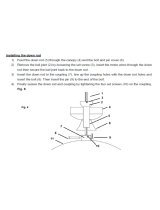
KE-430B, 430C series
5. ADJUSTMENT..................................... 99
5-1. Adjusting the needle bar height........................ 99
5-2. Adjusting the needle bar lift amount................. 100
5-3. Adjusting the driver needle guard .................... 101
5-4. Adjusting the needle clearance........................ 101
5-5. Adjusting the shuttle race thread guide............ 102
5-6. Adjusting the clearance between the shuttle
hook and bobbin case holder position bracket
(KE-484C)........................................................ 103
5-7. Adjusting the work clamp lift amount
(KE-430B, 430C, 431B, 431C, 433B) .............. 104
5-8. Adjusting the work clamp lift amount
(KE-432B, 432C).............................................. 104
5-9. Adjusting the work clamp lift amount (KE-434B,
434C, 435B, 435C, 436B, 436C, 484C)........... 105
5-10. Adjusting the button clamp lift amount
(BE-438B, 438C).............................................. 106
5-11. Work clamp pressure adjustment
(KE-432B, 432C).............................................. 107
5-12. Adjusting the holding pressure
(BE-438B, 438C).............................................. 107
5-13. Work clamp closing-distance adjustment
(KE-432B, 432C).............................................. 108
5-14. Adjusting the position of the button holder
(BE-438B, 438C).............................................. 109
5-15. Work clamp adjustment
(KE-435B, 435C, 436B, 436C)......................... 109
5-16. Changing the work clamp lift
(KE-435B, 435C, 436B, 436C)......................... 110
5-17. Adjusting the thread wiper................................ 111
5-18. Adjusting the thread take-up amount................ 114
5-19. Adjusting the movable knife.............................. 116
5-20. Adjusting the position of the thread trimming
link mechanism ................................................ 122
5-21. Adjusting the backlash...................................... 123
5-22. Adjusting the presser solenoid position
(Solenoid specifications).................................. 124
5-23. Adjusting the sensor perceive plate position
(Solenoid specifications).................................. 125
5-24. Adjusting the home position.............................. 126
5-25. Adjusting the needle up stop position ............... 129
5-26. Adjusting the tension of the upper shaft timing
belt ................................................................... 129
5-27. Checking the head position switch.................... 130
5-28. Work clamp interchangeability
(KE-433B)....................................................... 131
5-29. Work clamp interchangeability (KE-434B,
434C, 435B, 435C, 436B, 436C, 484C) ........... 131
5-30. Adjustment of air pressure (Pneumatic
specifications)................................................... 132
5-31. Adjustment of inner clamping device ................ 132
6. TROUBLESHOOTING ........................ 133
7. OPTIONAL PARTS............................. 136
8. ELECTRIC MECHANISM.................... 138
8-1. Precautions at the time of adjustment................. 138
8-2. Components inside the control box and
the operation panel........................................... 138
8-3. Fuse explanation ................................................ 139
8-4. Connectors ......................................................... 140
8-5. Explanation of the DIP switches ......................... 147
8-6. Explanation of the memory switches
(KE-430*, 431*, 432*, 433B, 434*, 435*,
484C, BE-438*)................................................ 150
8-7. Explanation of the memory switches
(KE-436B, 436C).............................................. 155
8-8. Setting the work clamp mode.............................. 159
8-9. Checking the input sensor and DIP switch
input.................................................................. 161
8-10. Checking the input voltage................................ 163
8-11. Clearing all memory settings............................. 164
8-12. Confirming software version ............................. 165
8-13. Table of error codes.......................................... 167
8-14. Troubleshooting................................................ 171
8-15. Control circuit block diagram............................. 190





















